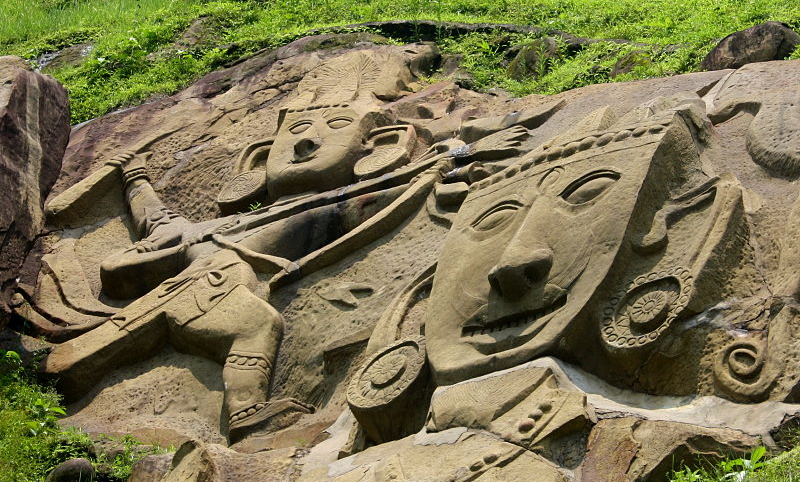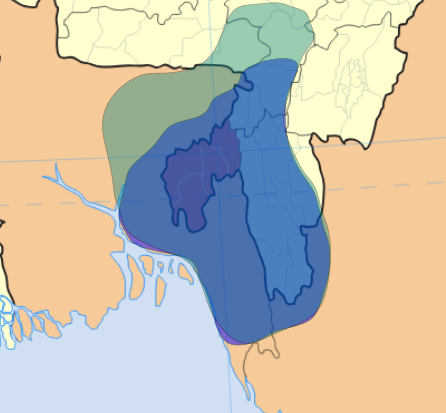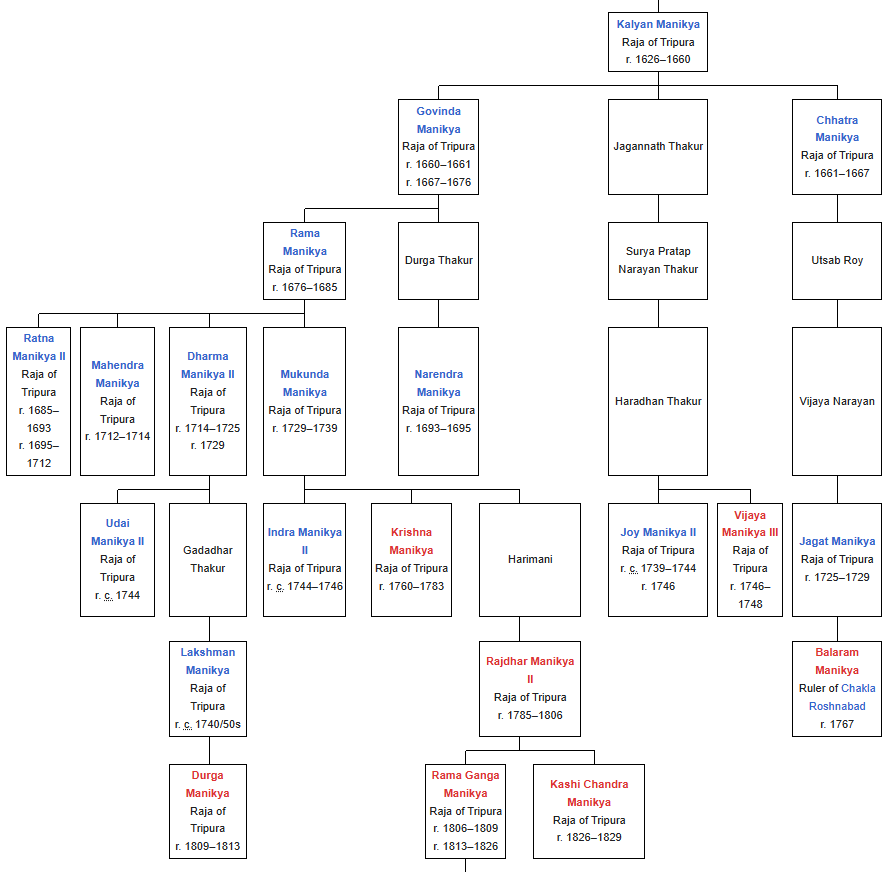Vijaya Manikya of Tripura – The Last Powerful Ruler in the Theatre


Very few realize that Tripura is a very powerful local hegemon which wielded much power holding both Bengal and Burma at bay for centuries. And Bijaya Manikya can be easily considered the greatest of the rulers of Tripura. The whole of North East India is split into two theatres – Ahom and Koch in the North and Tripura in the South.
The first major reference we hear of Tripura’s attacks outside it’s core territory is during the reign of Pratap Manikya where Tripura successfully invaded Bengal and annexed some border territories. Though Pratap Manikya was installed on the throne as a puppet, we would note that he seized control of the throne with the help of the head priest of the kingdom. Tripura’s power was reinstated in Heramba and Kuki areas were subdued and Chittagong was taken in 1435 during the reign of Dhanya Manikya. Bengal’s attempts to take Chittagong failed repeatedly. A fed up Bengal sent an army to conquer Tripura itself and defeating the Tripura garrisons including Chagaria which was held by Dhanya Manikya in person, the Bengal army reached Rangmati, the capital city of Tripura but had to retreat back because of severe flooding. Arakan was also sacked. His son Deva Manikya conquered the Bhuiyan and made Chittagong a formidable fortress. But, he fell under the influence of a Tantrik, possibly an agent of Bengal and sacrificed his main generals in the quest for power. However, when the Tantrik was outed, the Tantrik murdered the king and installed Indra Manikya, a son of the dead king from a wife who is under the Tantrik’s influence as the king. The Crown Prince Vijaya Manikya was imprisoned. After an year of anarchy, the Tantrik was ambushed and killed by the General Daitya Narayan. Indra Manikya was also killed and Vijaya Manikya who was released out of prison and made the king was married to Daitya Narayan’s daughter and on the other hand, he exerted complete control over Vijaya Manikya.
However, one would see that Daitya Narayan, though he controlled the king, he had interests of the kingdom at heart – a fine example being that of establishing terms with Kalinga which was already fighting heavily with Bengal through the introduction of Jagannatha cult after a pilgrimage to Puri. At a later date, we would see Vijaya has sending his eldest son Dungar to Kalinga to serve it’s ruler Mukunda Deva. With the control of Daitya Narayan and his brother Durlabh Narayan becoming too stifling, Vijaya Manikya enlisted the help of Daitya Narayan’s son-in-law to assassinate Daitya Narayan. But, Vijaya Manikya’s wife found about the plot and got Madhav killed. Vijaya Manikya was out of the capital city when that happened and angry at Madhav’s death he exiled the queen and seized power. With that, we see the start of reign of Vijaya Manikya.
The kingdom saw a massive territorial expansion in both directions – North and South. The Dimasa king Yasho Narayan, more popularly known as Satrudaman was his son in law and he gave away the Cachar Plains to him as dowry. Another important thing which happened during his reign was the mainstreaming of the title Manikya as the royal title. Awed at him, the Jaintiya king took the name Bijay Manik when he enticed Vijaya Manikya of Tripura for help against a possible invasion from Bengal. Vijaya Manikya acted as his protector but to assuage his prestige in his kingdom, Bijay Manik claimed, Vijaya Manikya, frightened of him, sent an elephant as present. Hearing this, Tripura duly invaded Jaintia and the king fled to Kachari country whose mediation pacified the king of Tripura. The marriage with Satrudaman, the crown prince may have happened during that period.
However, his greatest exploits were to be in the West. Sylhet was annexed from Bengal and when the Pathan troops holding Chittagong rebelled for more payments and marched till Rangmati, the rebellion was brutally crushed and a thousand Pathans were offered as human sacrifice. Hearing this, the Sultan of Bengal was very outraged and sent an army under his brother-in-law Mamarak. The Bengal army was defeated after a eight month long struggle and Mamarak, too, was offered as human sacrifice though there was some debate whether such senior an enemy officer should be offered as sacrifice as that would invite a serious retribution. However, Rajmala notes that Mamarak was allowed to read his prayers before his death.

But the changing political situation meant that the Sultan of Bengal wasn’t in a position to take any revenge for this personal affront. With the Mughals knocking at his doors, he had no option but to take the help of Tripura, the hegemon of the area and asked for an asylum for his family. But the haughtiness of Bengal’s envoy meant that no asylum was granted and Tripura invaded Bengal instead.
The downfall of such mighty a king and even the kingdom came from an unexpected corner – Kamata. When a small border clash between Kamata and Ahoms escalated into a full fledged war, the armies of Kamata under it’s king Narnarayan and his brother and commander-in-chief Sukladhwaja, more popularly known as Chilarai because of the speed with which he marched invaded Ahom country and conquered it. The king fled into the Naga Hills and had to sue for peace. And then, the Koch decided to march South. Hearing of the severe defeat of the Ahoms, Manipur submitted without a fight, but the Dimasa was surprised when the Koch armies appeared before Maibang. The Dimasa king Nirbhay Narayan tried to resist but was killed. The Jaintias submitted without a fight and the Koch armies marched on Sylhet, whose chief is noted as an Amil hinting that Tripura’s attack on Sylhet was a raid of plunder and not a permanent conquest. Then, led by Sukladhwaja in person, the Koch armies turned towards Tripura. While Rajmala is silent on the battle and as a matter of fact, the king died of small pox, Koch annals note that, in the mighty clash at Lankhai, while one third of the Koch army was destroyed along with leading commanders like Bhimabala, the king of Tripura, clearly, Vijaya Manikya was killed along with eighteen thousand Tripura troops. The numbers may have been inflated and this battle broke the power not just of Tripura but of the Koch as well!! Notes Rajmala on Vijaya Manikya,
A king like Dhanya Manikya is rare in the world. His son Deva-Manikya was a jewel. King Vijay Manikya is his son. The crest-jewels of other kings rub his feet. He possesses immense power and shines among the circle of kings.
The Cachar plans were occupied by the Koch and they carved a governorship in the area at a place which came to be known as Khaspur. Cachar was out of Tripura’s vassalage and Tripura itself was vassalized. Either the son of Vijaya Manikya or a brother of his had to sue for peace and one would see a slow decline of Tripura from then on. Before looking at what happened, let’s look at how this battle impacted the general area. The Koch power was broken and they had to limp back to Kamata. Tripura was in complete anarchy. And with no threat from the east, Bengal marched on Kalinga at the fateful battle of Gohora Tikiri, Mukunda Deva, the king of Kalinga was killed. Soon, we would see the whole of Kalinga conquered. By the time the Koch recovered and attacked Bengal, it was too late. In 1571, when the Koch attacked Bengal, Sukladhwaja himself was captured and Kamata would see a slow decline leading to it becoming a kingdom of no consequence not just in centuries but in decades.
What happened in Tripura? Tripura slipped into complete anarchy. Vijaya Manikya’s son and successor Ananta was assassinated by his father-in-law Gopi Prasad who seized the throne under the name Udaya Manikya. He started his career as a cook in the palace and grew to the level of the supreme commander. He forbade his daughter to commit Sati and in retaliation, she seized the throne. However, he shifted the capital city to Chandrapur which he renamed Udaipur. Bengal was happy at this turn of events – after a five year long clash centred around Meharkul, Tripura lost Chittagong. His son Loktar Fa became the king under the name Jaya Manikya but was a puppet under his uncle Rangan Narayan, a brother of Gopi Prasad. He tried to kill Amar Manikya, the main contender to the throne but was defeated by him and executed. Jaya Manikya was captured and murdered. Amar Manikya was born to a commoner and to the king but his brother Vijaya Manikya accepted him as a brother. These disturbances made Bhulua switch from Tripura to Bengal and it took three years for Tripura to subdue Bhulua. Amar Manikya seems to be as capable as his brother as we would see him advancing into Sylhet and bringing back it’s commander as a prisoner. Though Tripura gained a kind of dominance in Bengal theatre, the Burma theatre was heating up. An attack on Rasanga failed because the mercenaries(Portuguese?) defected and the armies of Tripura was chased back into Tripura proper before the Arakanese were chased away. The next battle was a disaster when the Pathans defected to the Arakanese side because of religion and Udaipur was taken and the king fled into the forests. A despondent Amar Manikya committed suicide and passed the throne to his son.
We would see the destruction of Tripura’s power from the time of the fateful Battle of Lankhai – civil wars and coups, and overreliance on mercenaries. By the time of Yaso Manikya, Tripura was but a shadow of it’s past power – though he was able to stabilize the position and gain some victories, the writing was on the wall when Tripura had to capitulate before a Mughal invasion in 1622 and the king was taken away as a prisoner to Delhi. He was offered the throne back and he refused to return, dying in Mathura in 1651. The Mughal and Arakanese raids spread complete anarchy and a level of internal order was restored by a prince from a cadet line Kalyan Manikya. But by 1658, the dynamics have completely changed with the Mughals forwarding alternate names to the king. This meddling and frequent wars and coups meant that Tripura would lose almost all of it’s possessions including Chittagong and the Chakma Country and even the plains area of Tripura was converted into a Zamindari.

The chaos which started in 1564 at Lankhai ended only in 1826 decades after the British took posession of Tripura. However, Tripura would still lose the Lushai Hills area in 1850s and never regained it.
References:
DISCLAIMER: The author is solely responsible for the views expressed in this article. The author carries the responsibility for citing and/or licensing of images utilized within the text.
